Inversion of Wind-Stress Drag Coefficient in Simulating Storm Surges by Means of Regularization Technique
Abstract
:1. Introduction
2. Materials and Methods
2.1. Numerical Adjoint Model
2.2. Regularization Technique
2.3. Numerical Experiment
3. Results and Discussion
3.1. Comparison between Simulation and Observation of Storm Surge Levels
3.2. Spatial Distribution of the Drag Coefficient
4. Conclusions
Author Contributions
Funding
Acknowledgments
Conflicts of Interest
References
- You, S.H.; Seo, J.W. Storm surge prediction using an artificial neural network model and cluster analysis. Nat. Hazards 2009, 1, 97–114. [Google Scholar] [CrossRef]
- Shaji, C.; Kar, S.K.; Vishal, T. Storm surge studies in the North Indian Ocean: A review. Indian J. Geo-Mar. Sci. 2014, 43, 125–147. [Google Scholar]
- Muis, S.; Verlaan, M.; Winsemius, H.C.; Aerts, J.C.J.H.; Ward, P.J. A global reanalysis of storm surges and extreme sea levels. Nat. Commun. 2016, 7, 11969. [Google Scholar] [CrossRef] [Green Version]
- Zhao, Y.B.; Liang, X.S. Cause and underlying dynamic processes of the mid-winter suppression in the North Pacific storm track. Sci. China Earth Sci. 2019, 162, 872–890. [Google Scholar] [CrossRef]
- Lin, N.; Emanuel, K.; Oppenheimer, M.; Vanmarcke, E. Physically based assessment of hurricane surge threat under climate change. Nat. Clim. Chang. 2012, 2, 462–467. [Google Scholar] [CrossRef] [Green Version]
- Liu, H.Q.; Zhang, K.Q.; Li, Y.P.; Xie, L.A. Numerical study of the sensitivity of mangroves in reducing storm surge and flooding to hurricane characteristics in southern Florida. Cont. Shelf Res. 2013, 64, 51–65. [Google Scholar] [CrossRef]
- Haigh, I.D.; Wijeratne, E.M.S.; MacPherson, L.R.; Pattiaratchi, C.B.; Mason, M.S.; Crompton, R.P.; George, S. Estimating present day extreme water level exceedance probabilities around the coastline of Australia: Tides, extra-tropical storm surges and mean sea level. Clim. Dyn. 2014, 42, 121–138. [Google Scholar] [CrossRef]
- Dong, S.; Gao, J.G.; Li, X.; Wei, Y.; Wang, L. A Storm Surge Intensity Classification Based on Extreme Water Level and Concomitant Wave Height. J. Ocean Univ. China 2015, 14, 237–244. [Google Scholar] [CrossRef]
- Zhang, H.; Cheng, W.C.; Qiu, X.X.; Feng, X.B.; Gong, W.P. Tide-surge interaction along the east coast of the Leizhou Peninsula, South China Sea. Cont. Shelf Res. 2017, 142, 32–49. [Google Scholar] [CrossRef]
- Olbert, A.I.; Nash, S.; Cunnane, C.; Hartnett, M. Tide-surge interactions and their effects on total sea levels in Irish coastal waters. Ocean Dyn. 2013, 63, 599–614. [Google Scholar] [CrossRef]
- Zheng, J.H.; Wang, J.C.; Zhou, C.Y.; Zhao, H.J.; Sang, S. Numerical simulation of typhoon-induced storm surge along Jiangsu coast, Part II: Calculation of storm surge. Water Sci. Eng. 2017, 10, 8–16. [Google Scholar] [CrossRef]
- Ridder, N.; De, V.H.; Drijfhout, S.; Henk, V.D.B.; Van, M.E.; De, V.H. Extreme storm surge modeling in the North Sea. Ocean Dyn. 2018, 68, 255–272. [Google Scholar] [CrossRef]
- Lionello, P.; Sanna, A.; Elvini, E.; Mufato, R. A data assimilation procedure for operational prediction of storm surge in the northern Adriatic Sea. Cont. Shelf Res. 2006, 26, 539–553. [Google Scholar] [CrossRef]
- Peng, S.Q.; Xie, L.A. Effect of determining initial conditions by four-dimensional variational data assimilation on storm surge forecasting. Ocean Model. 2006, 14, 1–18. [Google Scholar] [CrossRef] [Green Version]
- Peng, S.Q.; Xie, L.A.; Pietrafesa, L.J. Correcting the errors in the initial conditions and wind stress in storm surge simulation using an adjoint optimal technique. Ocean Model. 2007, 18, 175–193. [Google Scholar] [CrossRef]
- Yin, B.S.; Xu, Z.H.; Huang, Y.; Lin, X. Simulating a typhoon storm surge in the East Sea of China using a coupled model. Prog. Nat. Sci. 2009, 19, 65–71. [Google Scholar] [CrossRef]
- Fan, L.L.; Liu, M.M.; Chen, H.B.; Lu, X.Q. Numerical study on the spatially varying drag coefficient in simulation of storm surges employing the adjoint method. Chin. J. Oceanol. Limnol. 2011, 29, 702–717. [Google Scholar] [CrossRef]
- Li, Y.N.; Peng, S.Q.; Yan, J.; Xie, L.A. On improving storm surge forecasting using an adjoint optimal technique. Ocean Model. 2013, 72, 185–197. [Google Scholar] [CrossRef]
- Feng, J.L.; Jiang, W.S.; Bian, C.W. Numerieal Prediction of Storm Surge in the Qingdao Area Under the Impact of Climate Change. J. Ocean Univ. China 2014, 13, 539–551. [Google Scholar] [CrossRef]
- Xu, J.L.; Zhang, Y.H.; Cao, A.Z.; Liu, Q.; Lv, X.Q. Effects of tide-surge interactions on storm surges along the coast of the Bohai Sea, Yellow Sea, and East China Sea. Sci. China Earth Sci. 2016, 59, 1308–1316. [Google Scholar] [CrossRef]
- Tikhonov, A.N. Solution of incorrectly formulated problems and the regularization method. Sov. Math. Dokl. 1963, 5, 1035–1038. [Google Scholar]
- Morozov, V.A. Methods for Solving Incorrectly Posed Problems; Springer: New York, NY, USA, 1984; p. 65. [Google Scholar]
- Chen, H.B.; Cao, A.Z.; Zhang, J.C.; Miao, C.B.; Lv, X.Q. Estimation of spatially varying open boundary conditions for a numerical internal tidal model with adjoint method. Math. Comput. Simul. 2014, 97, 14–38. [Google Scholar] [CrossRef]
- Chen, J.; Weisberg, R.H.; Liu, Y.; Zheng, L. The Tampa Bay Coastal Ocean Circulation Model performance for Hurricane Irma. MTS J. 2018, 52, 33–42. [Google Scholar] [CrossRef]
- Jelesnianski, C.P. A numerical calculation of storm tides induced by a tropical storm impinging on a continental shelf. Mon. Weather Rev. 1965, 93, 343–358. [Google Scholar] [CrossRef]
- He, Y.J.; Lu, X.Q.; Qiu, Z.F.; Zhao, J.P. Shallow water tidal constituents in the Bohai Sea and the Yellow Sea from a numerical adjoint model with TOPEX/POSEIDON altimeter data. Cont. Shelf Res. 2004, 24, 1521–1529. [Google Scholar] [CrossRef]
- Liu, Y.; Weisberg, R.H. Momentum balance diagnoses for the West Florida Shelf. Cont. Shelf Res. 2005, 25, 2054–2074. [Google Scholar] [CrossRef]

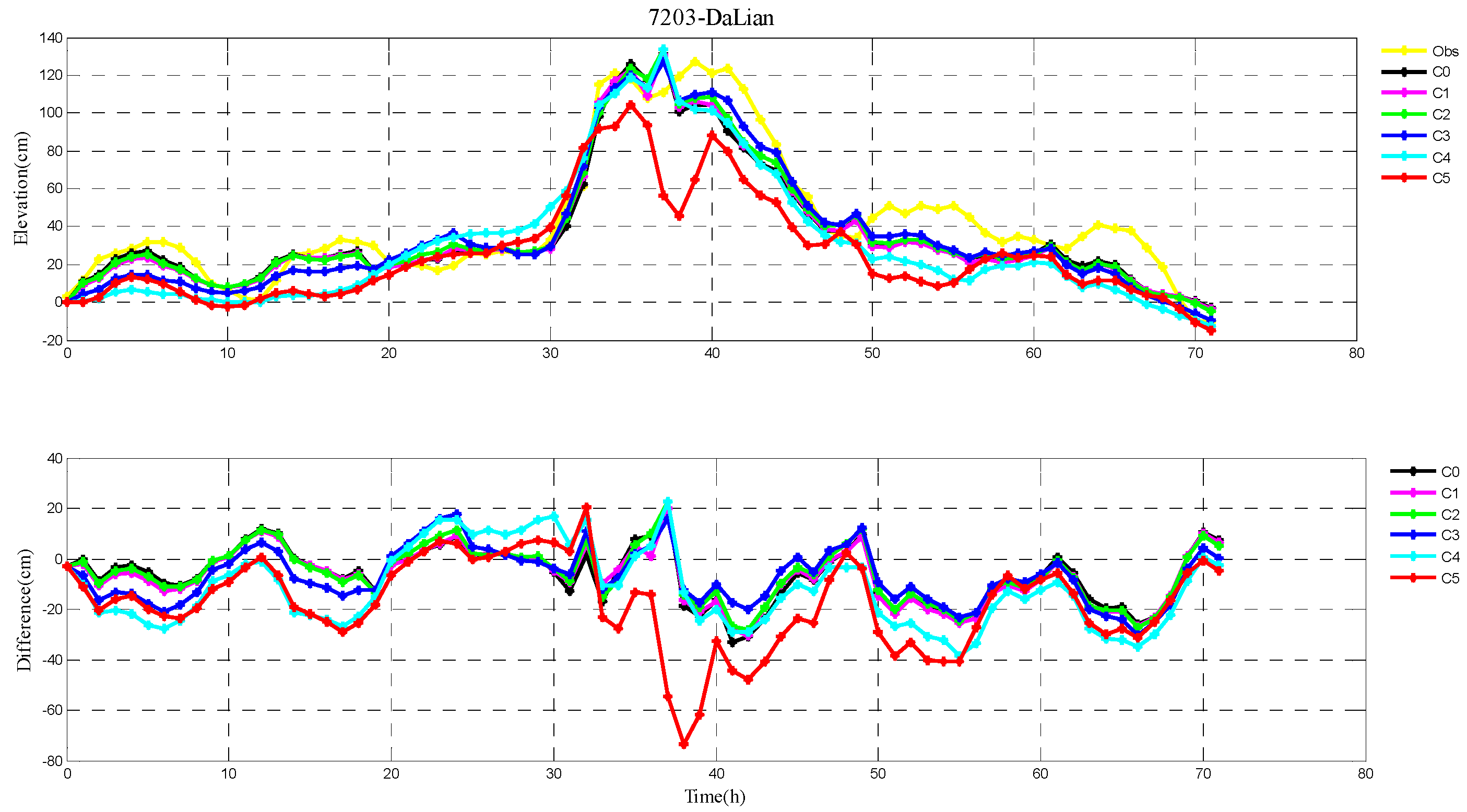
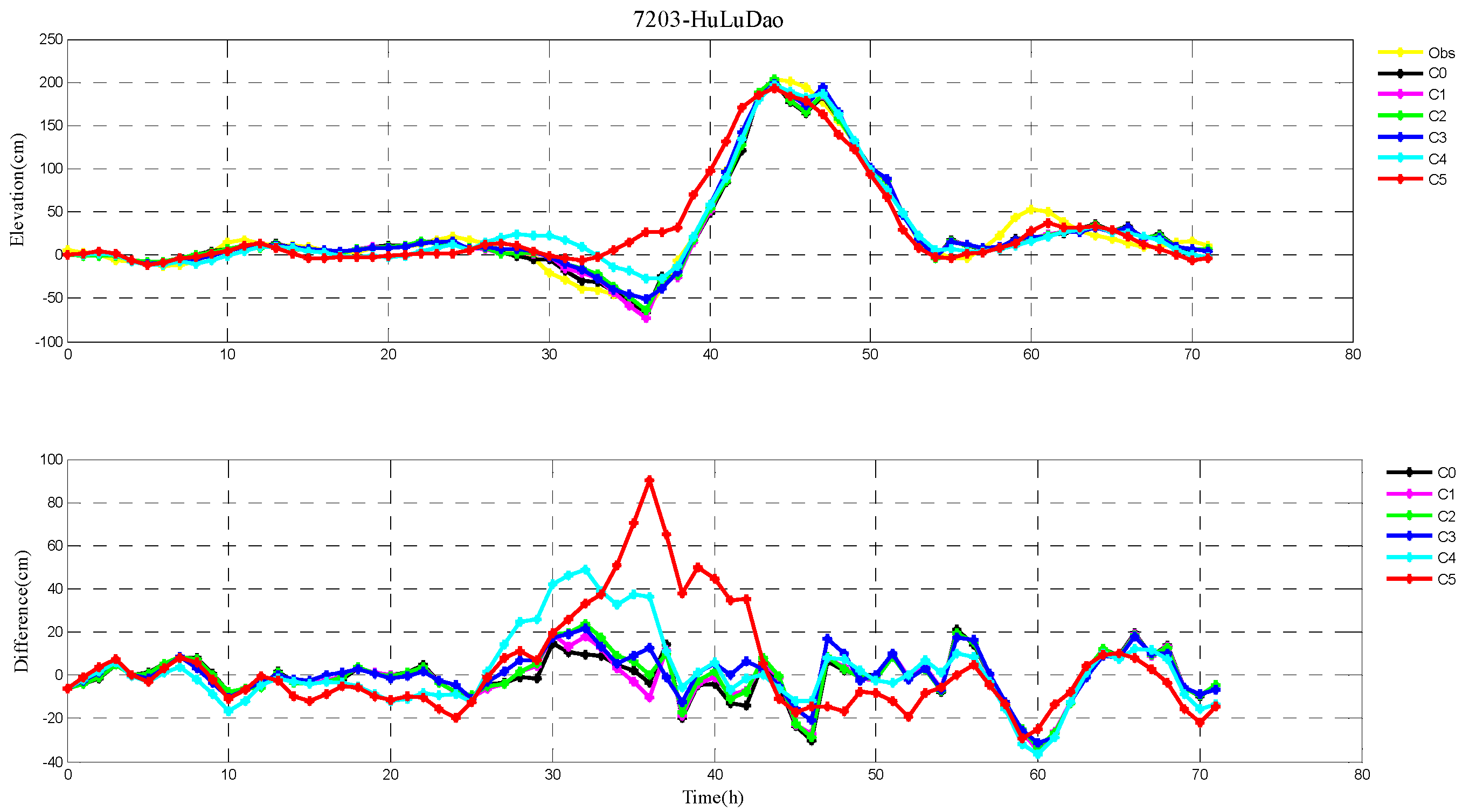
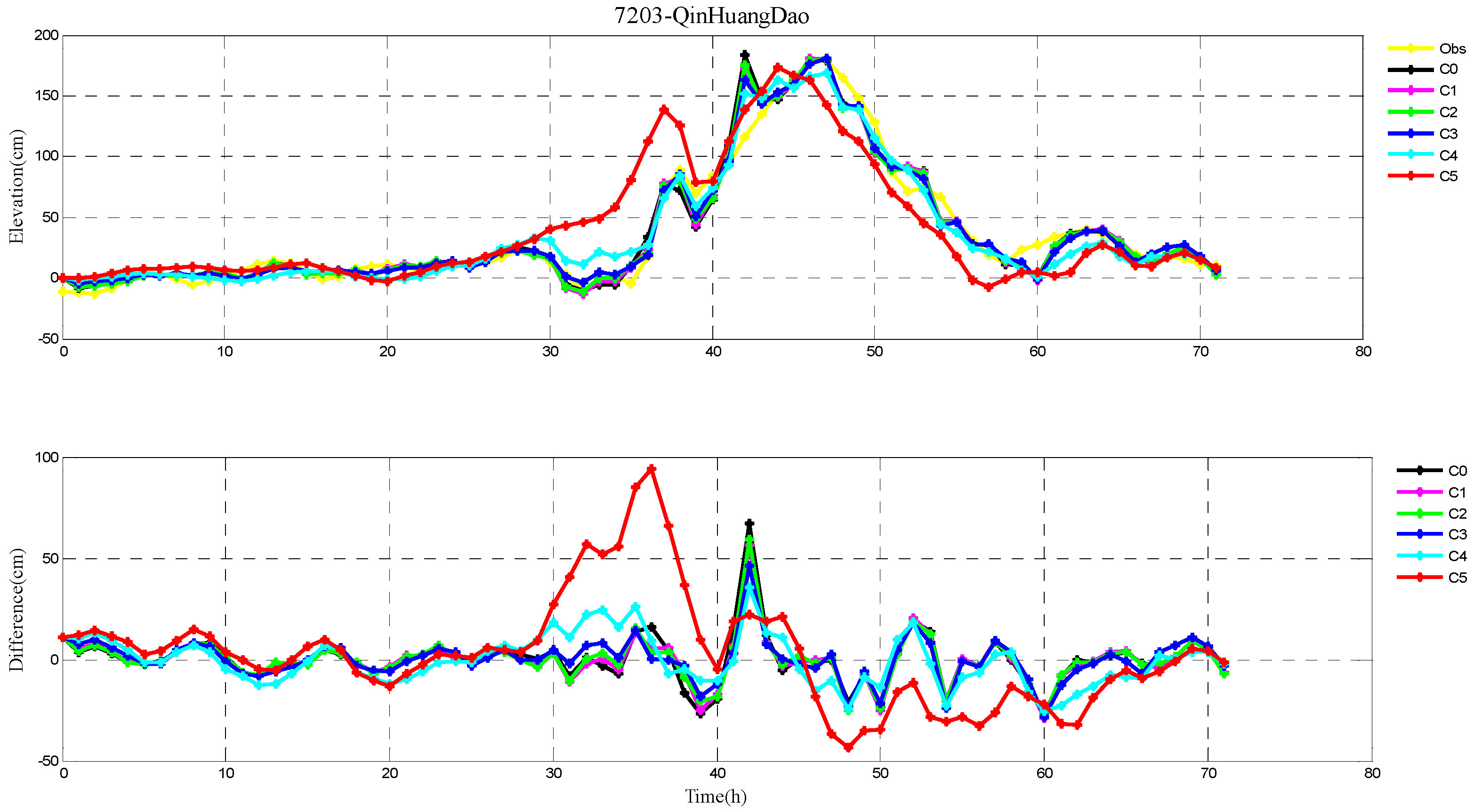

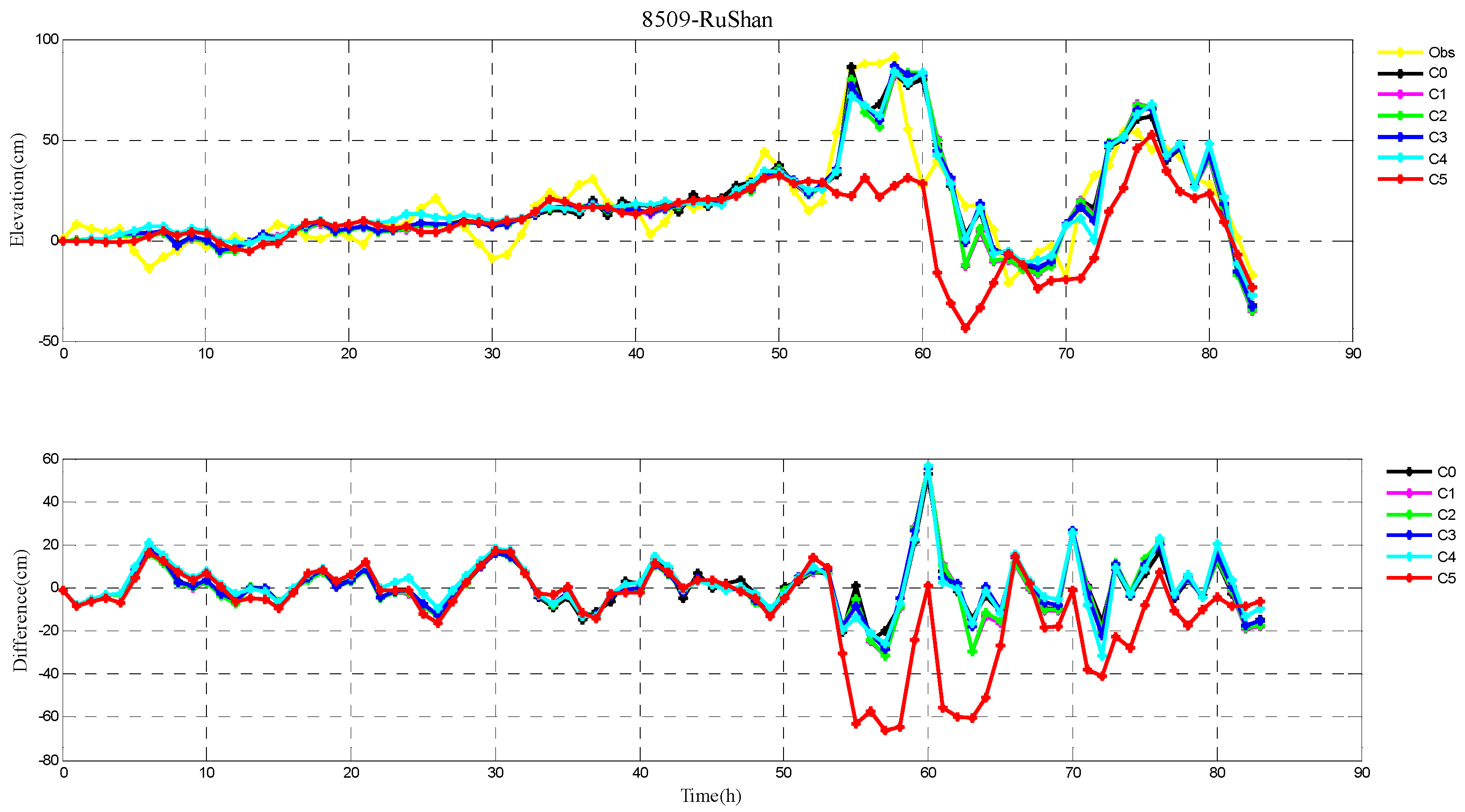
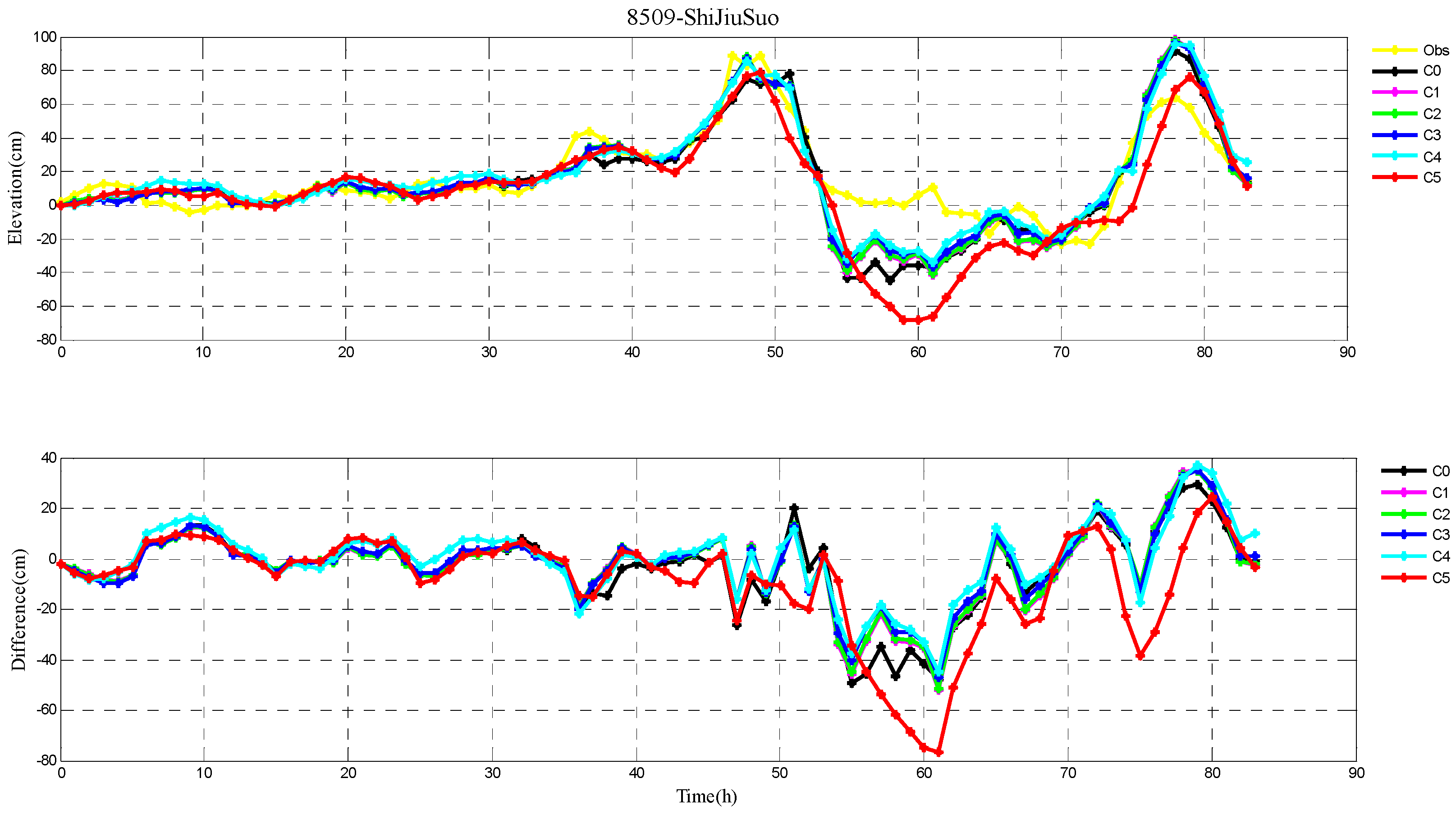

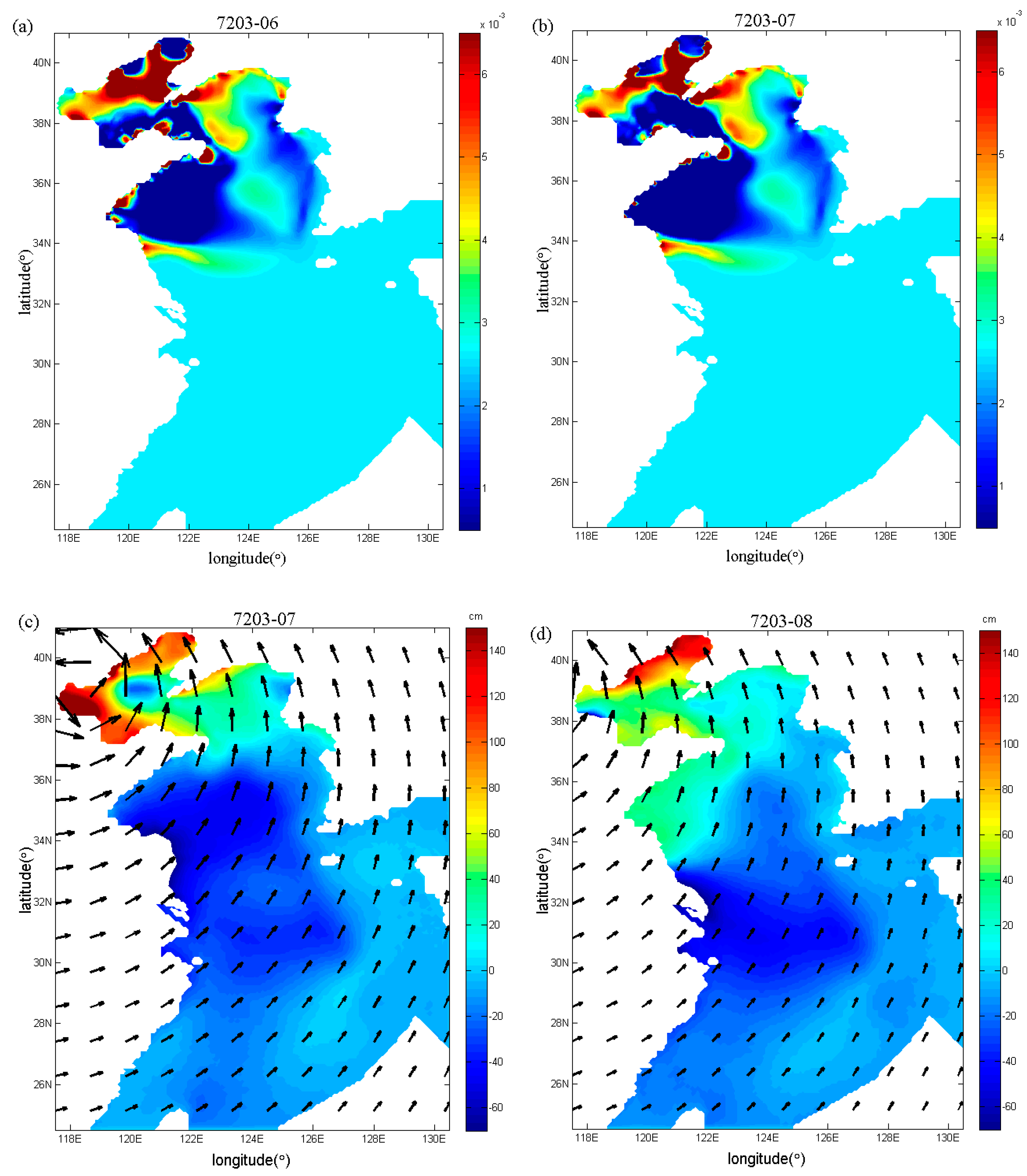
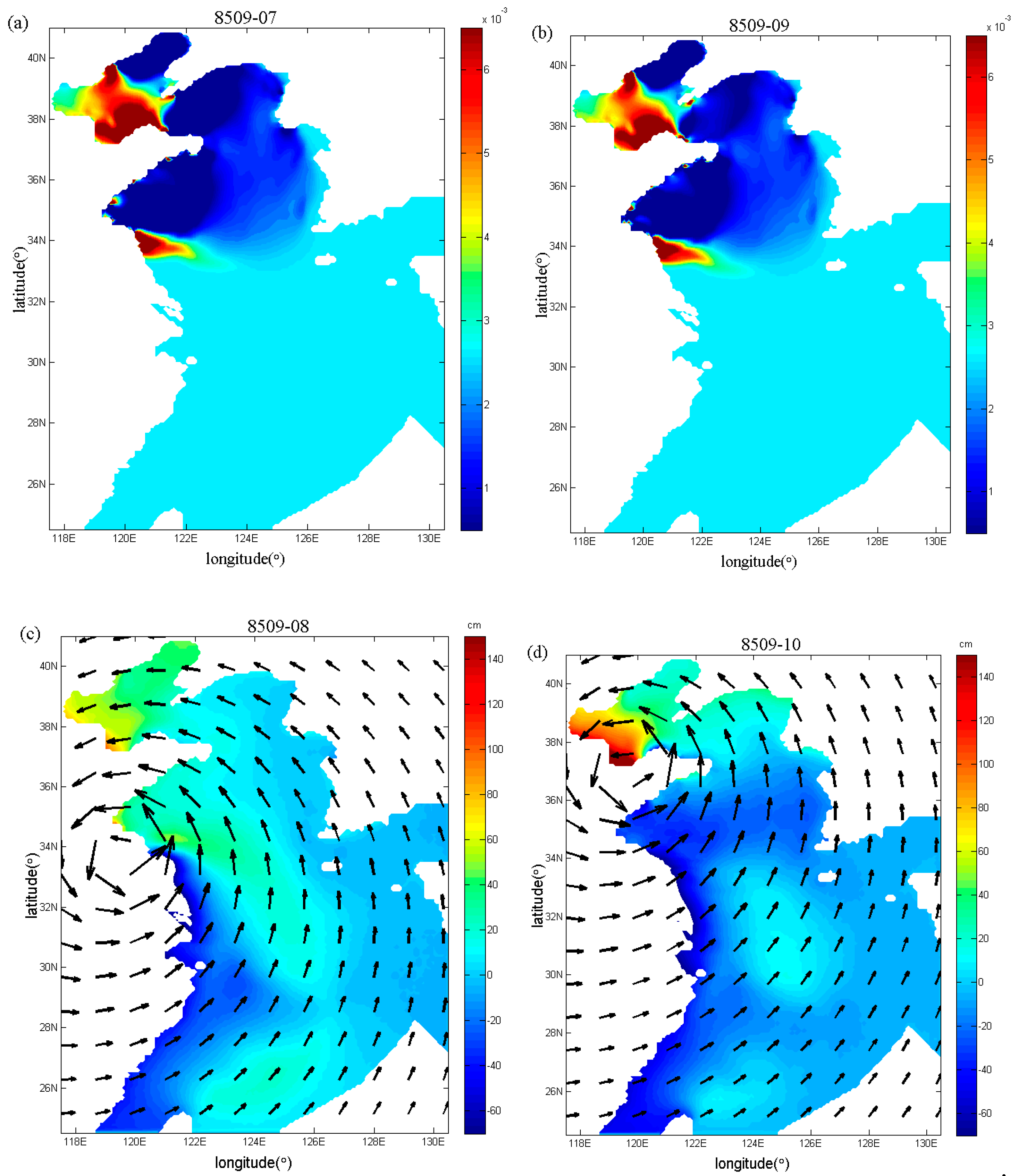
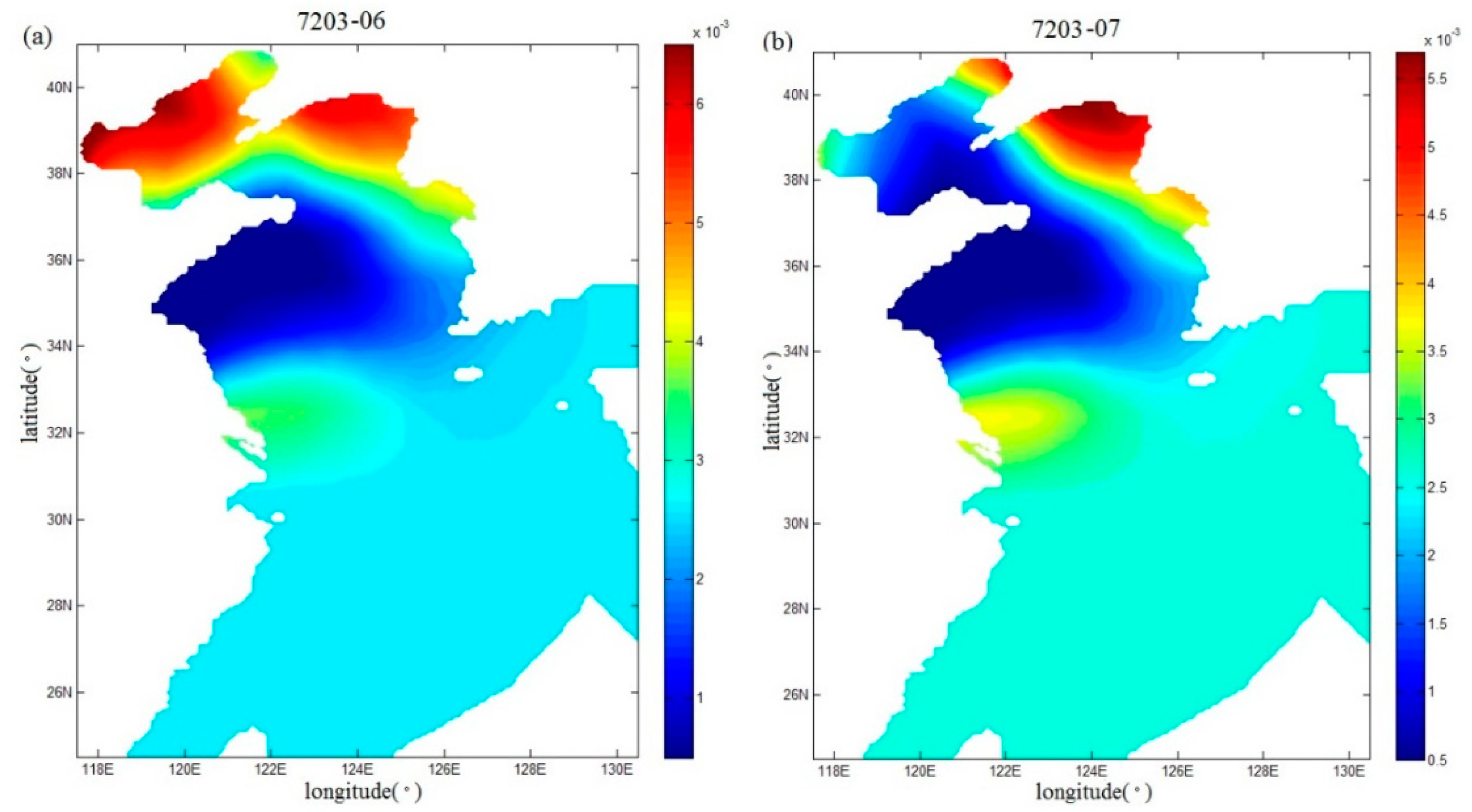
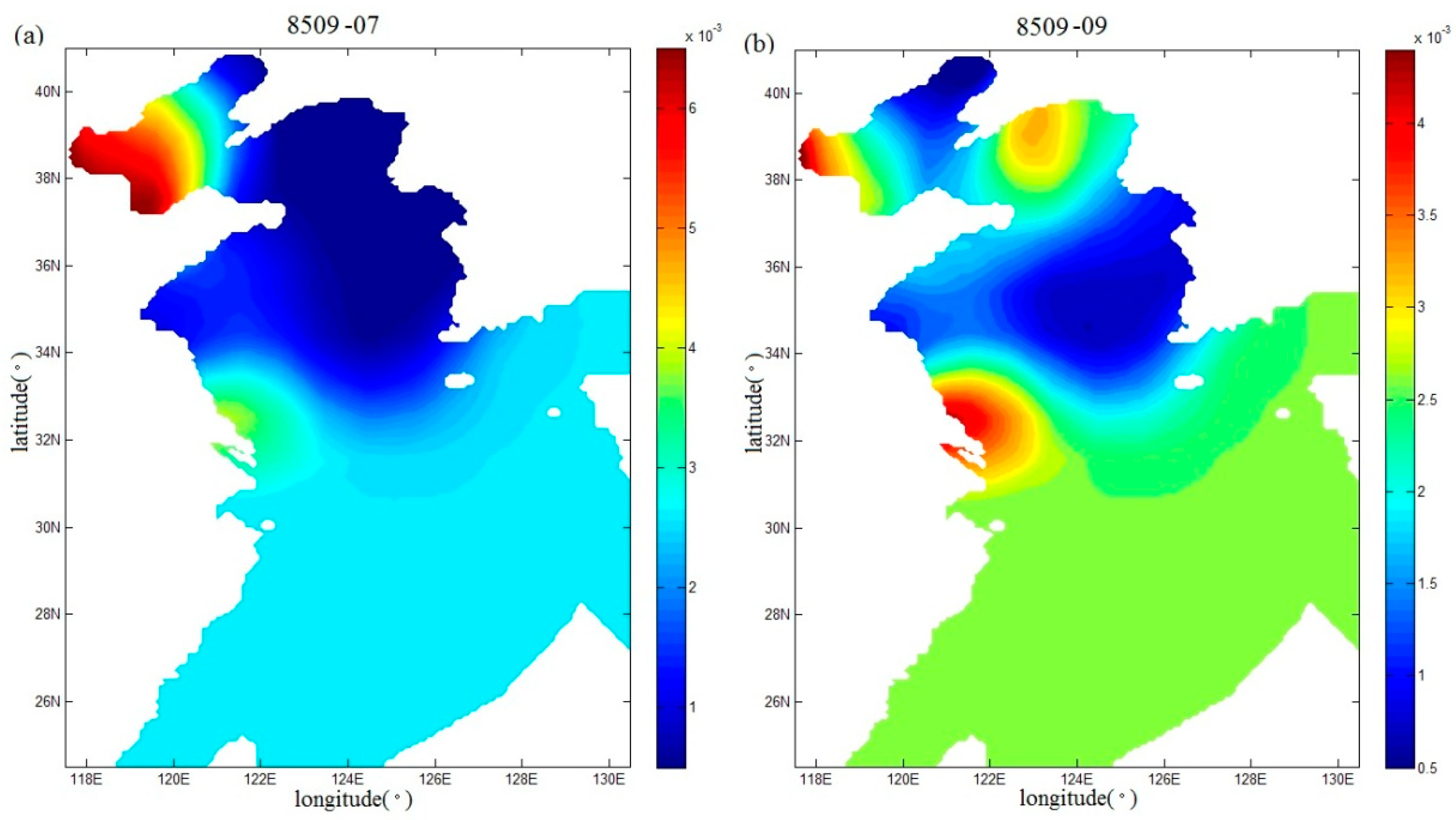
| Case | 1 | 2 | 3 | 4 | 5 | 6 | 7 | 8 | 9 | 10 | 11 | 12 | Mean |
|---|---|---|---|---|---|---|---|---|---|---|---|---|---|
| C0 | 11 | 7 | 5 | 6 | 11 | 16 | 29 | 19 | 22 | 27 | 20 | 12 | 15 |
| C1 | 6 | 7 | 4 | 5 | 6 | 14 | 26 | 18 | 21 | 26 | 19 | 12 | 14 |
| C2 | 5 | 7 | 5 | 5 | 5 | 16 | 27 | 18 | 19 | 25 | 19 | 12 | 14 |
| C3 | 7 | 8 | 6 | 6 | 6 | 14 | 24 | 16 | 16 | 23 | 18 | 13 | 13 |
| C4 | 10 | 11 | 10 | 9 | 11 | 20 | 22 | 19 | 20 | 23 | 19 | 15 | 16 |
| C5 | 10 | 11 | 10 | 9 | 8 | 35 | 45 | 32 | 24 | 21 | 22 | 14 | 20 |
| Case | 1 | 2 | 3 | 4 | 5 | 6 | 7 | 8 | 9 | 10 | 11 | 12 | 13 | 14 | Mean |
|---|---|---|---|---|---|---|---|---|---|---|---|---|---|---|---|
| C0 | 11 | 8 | 4 | 7 | 10 | 20 | 11 | 15 | 39 | 23 | 31 | 74 | 32 | 37 | 23 |
| C1 | 11 | 7 | 4 | 7 | 10 | 9 | 7 | 10 | 7 | 21 | 32 | 66 | 36 | 43 | 19 |
| C2 | 11 | 7 | 4 | 7 | 10 | 9 | 7 | 10 | 7 | 21 | 31 | 66 | 35 | 42 | 19 |
| C3 | 11 | 8 | 4 | 7 | 10 | 10 | 8 | 9 | 7 | 19 | 29 | 67 | 34 | 40 | 19 |
| C4 | 13 | 11 | 6 | 8 | 12 | 11 | 10 | 8 | 8 | 18 | 27 | 69 | 32 | 39 | 19 |
| C5 | 13 | 7 | 5 | 9 | 10 | 9 | 7 | 11 | 11 | 35 | 49 | 101 | 38 | 30 | 24 |
| Tide Stations | 7203 | 8509 | ||||||||||
|---|---|---|---|---|---|---|---|---|---|---|---|---|
| C0 | C1 | C2 | C3 | C4 | C5 | C0 | C1 | C2 | C3 | C4 | C5 | |
| DaLian | 13 | 13 | 12 | 13 | 19 | 25 | 56 | 50 | 50 | 50 | 52 | 73 |
| YingKou | 13 | 11 | 11 | 12 | 14 | 19 | * | * | * | * | * | * |
| HuLuDao | 10 | 10 | 11 | 10 | 16 | 23 | * | * | * | * | * | * |
| QinHuangDao | 11 | 10 | 10 | 9 | 11 | 27 | 27 | 31 | 31 | 29 | 27 | 27 |
| LongKou | 19 | 17 | 18 | 16 | 19 | 23 | * | * | * | * | * | * |
| YanTai | 26 | 26 | 26 | 22 | 26 | 27 | 22 | 24 | 23 | 22 | 21 | 23 |
| RuShan | 9 | 7 | 7 | 7 | 10 | 25 | 10 | 11 | 11 | 11 | 11 | 19 |
| QingDao | 16 | 15 | 15 | 15 | 14 | 19 | 14 | 14 | 13 | 13 | 12 | 20 |
| ShiJiuSuo | 18 | 15 | 15 | 13 | 12 | 19 | 16 | 15 | 14 | 14 | 14 | 24 |
| LianYunGang | 26 | 23 | 23 | 20 | 17 | 25 | 34 | 16 | 16 | 16 | 17 | 25 |
| Mean | 16 | 15 | 15 | 14 | 16 | 23 | 26 | 23 | 23 | 22 | 22 | 30 |
| Typhoon | 7203 | |||||||
|---|---|---|---|---|---|---|---|---|
| Tide Stations | DaLian | HuLuDao | QinHuangDao | RuShan | ||||
| Peak surge (cm) | Peak time (h) | Peak surge (cm) | Peak time (h) | Peak surge (cm) | Peak time (h) | Peak surge (cm) | Peak time (h) | |
| C0 | 135 | 35.6 | 211 | 43.6 | 185 | 42 | 55 | 46.6 |
| C1 | 136 | 36.3 | 213 | 43.7 | 182 | 45.9 | 54 | 46.5 |
| C2 | 136 | 36.3 | 212 | 43.7 | 181 | 45.8 | 56 | 46.5 |
| C3 | 134 | 36.3 | 204 | 43.7 | 181 | 46.9 | 57 | 46.9 |
| C4 | 137 | 36.3 | 199 | 43.8 | 172 | 43.6 | 58 | 47.5 |
| C5 | 106 | 35.3 | 193 | 43.9 | 173 | 43.0 | 62 | 52.7 |
| Observation | 127 | 39 | 204 | 44 | 181 | 46 | 53 | 47 |
| Typhoon | 8509 | |||||
|---|---|---|---|---|---|---|
| Tide Stations | RuShan | ShiJiusuo | LianYungang | |||
| Peak surge (cm) | Peak time (h) | Peak surge (cm) | Peak time (h) | Peak surge (cm) | Peak time (h) | |
| C0 | 91 | 55.2 | 92 | 50.6 | 196 | 49 |
| C1 | 84 | 58.3 | 88 | 48.1 | 113 | 48 |
| C2 | 85 | 58.3 | 88 | 48.1 | 113 | 48 |
| C3 | 88 | 58.2 | 87 | 48.1 | 111 | 48 |
| C4 | 84 | 58 | 86 | 48.1 | 109 | 48 |
| C5 | 53 | 75 | 79 | 48.5 | 114 | 48.3 |
| Observation | 92 | 58 | 89 | 49 | 95 | 48 |
© 2019 by the authors. Licensee MDPI, Basel, Switzerland. This article is an open access article distributed under the terms and conditions of the Creative Commons Attribution (CC BY) license (http://creativecommons.org/licenses/by/4.0/).
Share and Cite
Xu, J.; Zhang, Y.; Lv, X.; Liu, Q. Inversion of Wind-Stress Drag Coefficient in Simulating Storm Surges by Means of Regularization Technique. Int. J. Environ. Res. Public Health 2019, 16, 3591. https://0-doi-org.brum.beds.ac.uk/10.3390/ijerph16193591
Xu J, Zhang Y, Lv X, Liu Q. Inversion of Wind-Stress Drag Coefficient in Simulating Storm Surges by Means of Regularization Technique. International Journal of Environmental Research and Public Health. 2019; 16(19):3591. https://0-doi-org.brum.beds.ac.uk/10.3390/ijerph16193591
Chicago/Turabian StyleXu, Junli, Yuhong Zhang, Xianqing Lv, and Qiang Liu. 2019. "Inversion of Wind-Stress Drag Coefficient in Simulating Storm Surges by Means of Regularization Technique" International Journal of Environmental Research and Public Health 16, no. 19: 3591. https://0-doi-org.brum.beds.ac.uk/10.3390/ijerph16193591




